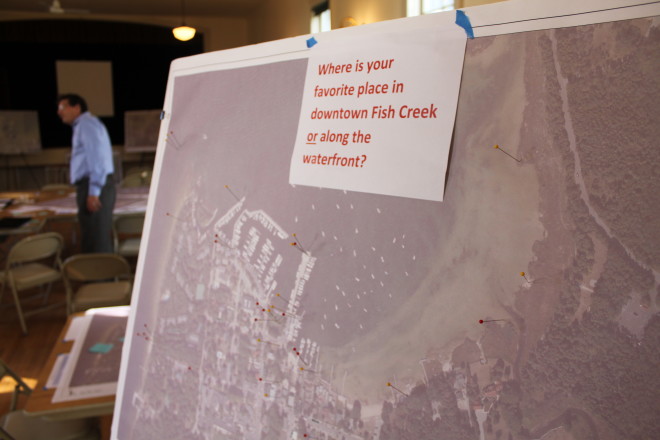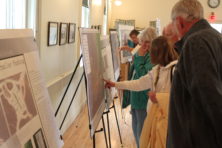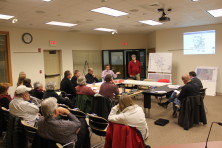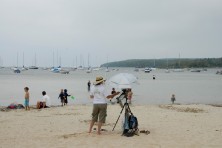Q&A With Andrew Dane of the Fish Creek Waterfront Redevelopment
- Share
- Tweet
- Pin
- Share

The Pulse caught up with Andrew Dane, Community Development and sustainability expert with Short Elliot Hendrickson, charged with planning the redevelopment of Fish Creek’s waterfront.
The firm held a workshop this week inviting suggestions from the public about possible improvements. Dane listed storm water runoff, parking and making the harbor more efficient as primary goals for the group of planners, architects and engineers. The public wanted to make sure Fish Creek maintained its quaint, small-town experience.
Jackson Parr (JP): Give an overview of the workshop process and what has been going on the past few days.
Andrew Dane (AD): We kick started things off with a couple of tours. We went out and took a look at Fish Creek and the town beach. Then we took a walk along the main street and looked at the harbor area. We took a look at the town dock and learned about some of the boat launches and some of the congestion that is happening down there. We had about 40 people turn out for the walking tours. I thought that was a pretty nice turnout for 7:30 in the morning.
Then we came back and had an opportunity to meet with the steering committee, reflect on the comments and feedback that we got from folks. Our design team had a mix of some water resource engineers, planners, architects and some design folks and then we jumped into our design workshop. We really started looking at storm water management in the Fish Creek area, looking at parking and sort of traffic flow and then we’re looking at the functionality of the harbor.
JP: Were there any ideas that came up that your team didn’t think of or that you could really sink your teeth into?
AD: There are a couple of big things that come to my mind. We knew from the get go that the key guiding principle is to not mess things up. There are a lot of things that are working really well about the community but one of the areas, it was probably the number one issue on the priority from the survey, is parking.
We’ve started to explore some ideas for some off-site parking as we look at welcoming people into the community. You take the experience of coming in and driving around for a half hour looking for a parking space and maybe getting a little frustrated. Instead, somebody comes in and through some changes in the environment, through signage, through landscaping, they are welcomed in, they know exactly where they are going. They land there, and then just as you do when you go to any downtown environment, you park once and then you walk around. It really fits in nicely with the concept of walk-able, mixed-use downtown, which you have here. For some of these areas you may be close enough to simply walk into town.
If you’re looking at other areas, maybe up on the bluff, maybe a little bit north out towards the high school, there may be opportunities there to look at a trolley, perhaps bicycle rentals, perhaps good trails that would weave you into town. One of the nice things about doing that is that the parking is so seasonal so there’s not a huge parking problem for many months out of the year. So rather than coming here and asphalting a bunch of the downtown to address seasonal demand, look at taking existing lots or perhaps additional lots but located outside of the downtown. Even though this is a waterfront plan, a lot of those uses of course drive increased demand for parking so parking is definitely something we’re going to be spending quite a bit of time on.
JP: When comments about wider streets and wider sidewalks came up, residents were saying, “Wait a minute, the reason people are here is because it’s cozy.” How do you address the interplay between making improvements and keeping the quaint feel of the town?
AD: I think the way that you deal with that is work with a planning firm who understand some of the nuance behind that. The typical American way to solve a problem like this is to widen the road, add a dedicated bike lane, add a dedicated walk lane, add more traffic, pave over more parking lots, separate the uses. It’s kind of what got us into suburban sprawl mentality. I think what makes Fish Creek charming is the cacophony, the mixing of uses and embracing of street life so the streets become and extension of the businesses. It’s going to be block by block, parcel by parcel. It’s not going to be, ‘Ok come in here and stripe every street in the downtown for bicycle lanes or we need to widen the roads so we can get more traffic through here faster.’
JP: What is the timeline for the project and your involvement in the planning?
AD: We will come back, I’m thinking probably the first part of December, we will come back up here and do a report to the steering committee, open to the public showing what we’ve come up with and the outcome of this process. We will clean up some of the maps and drawings and that will provide yet another round of feedback into the design and the plan. Then I would anticipate putting all of this stuff up on our website and then continuing this dialogue and discussion but more of an online basis through the winter.
The goal is still to have this thing adopted by next June or July so we would have at least another couple open workshops or open houses in the spring where we would come out and have nicer versions of these plans for people to look at. The approval process will probably be the Harbor Commission and the Steering Committee would make a recommendation to the town board to adopt this plan. There are pieces in here that one group might be able to bite off and get moving forward. Typically, these are long range planning documents that hopefully provide some value five, ten years into the future. But really it’s up to the community to implement them.




